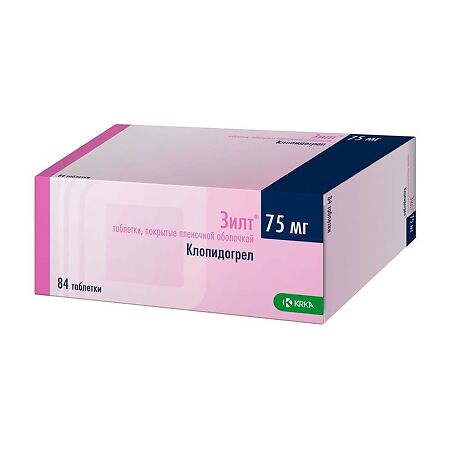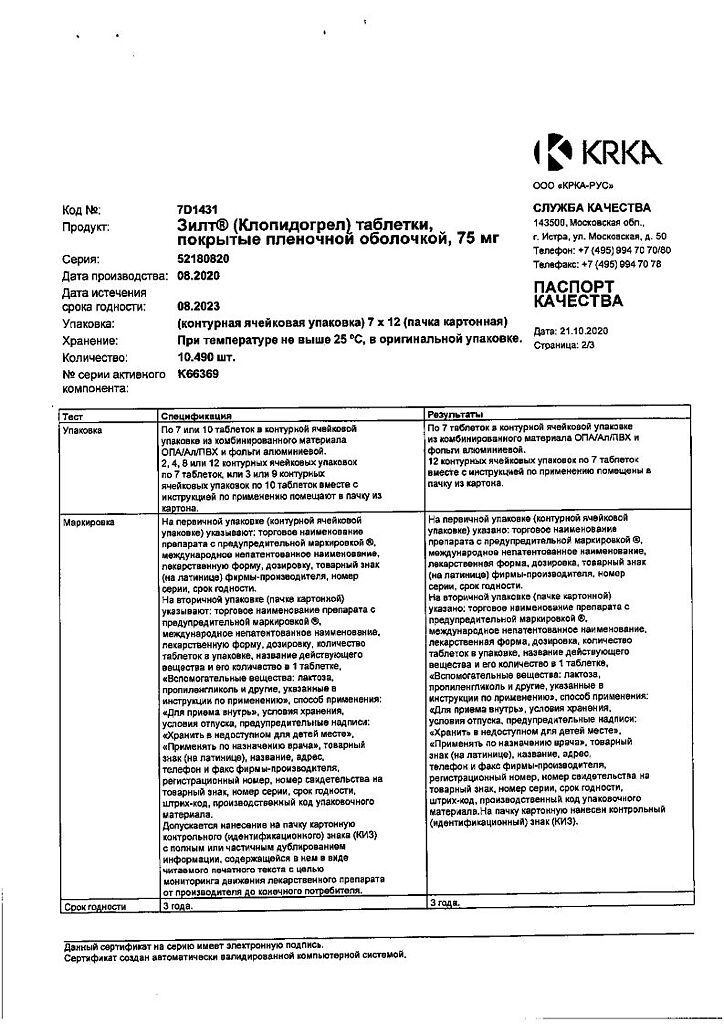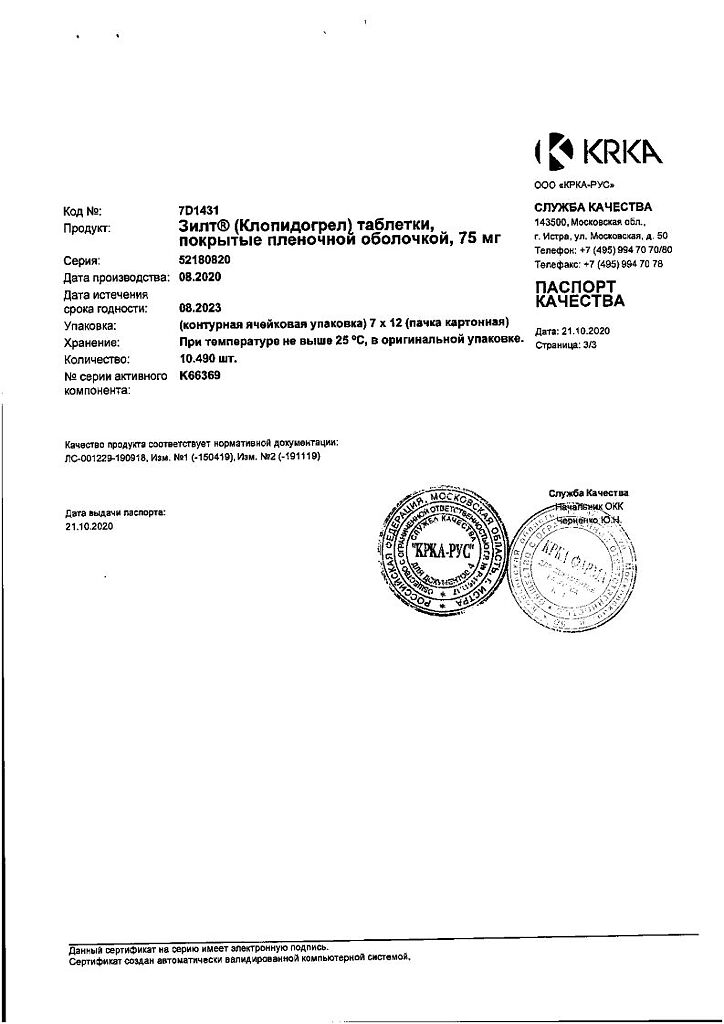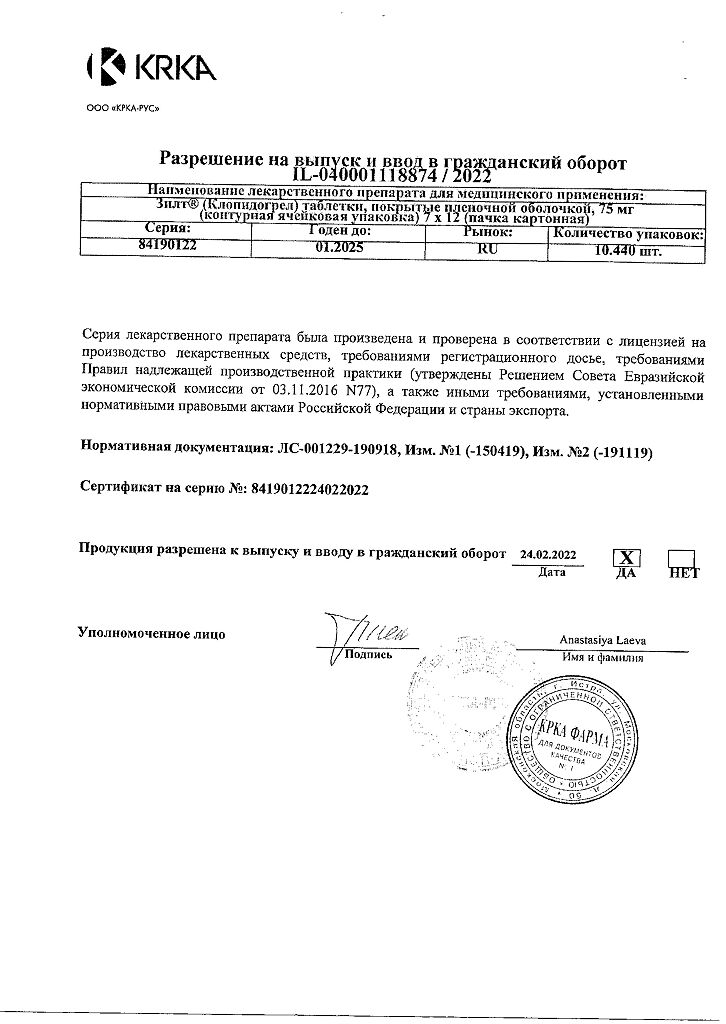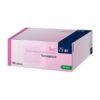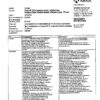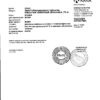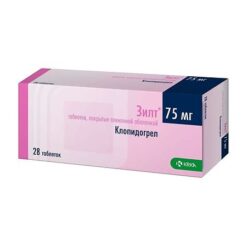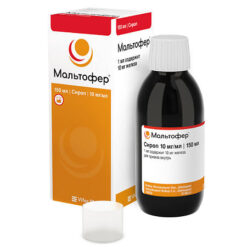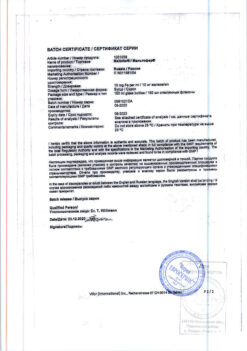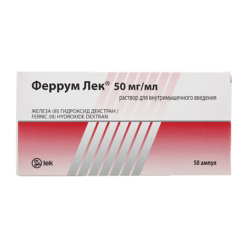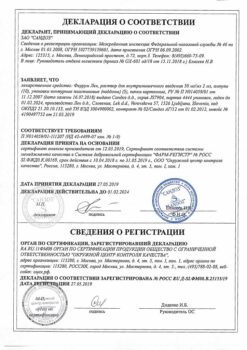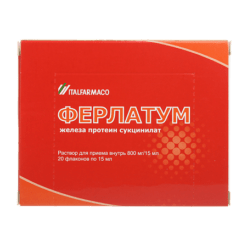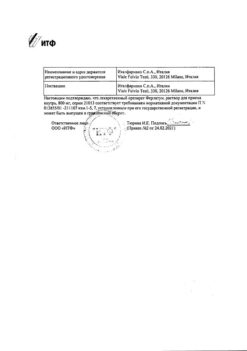No products in the cart.
Zylt, 75 mg 84 pcs.
€57.12 €47.60
Description
Prevention of thromboembolism, Prevention of thrombosis, Prevention of heart attacks and strokes, Prevention of heart attack
Secondary prevention of atherothrombotic complications:
- in adult patients after a recent myocardial infarction (several days to 35 days old), a recent ischemic stroke (seven days to six months old), or diagnosed peripheral arterial occlusive disease, clopidogrel administration reduced the frequency of the combined end point which included recurrent ischemic stroke (fatal or not), recurrent myocardial infarction (fatal or not), and other cardiovascular death;
- in adult patients with acute coronary syndrome:
acute coronary syndrome without ST-segment elevation (unstable angina/ myocardial infarction without Q-wave), including patients who should receive drug treatment, and patients who are shown percutaneous coronary intervention (with or without stenting) or coronary artery bypass surgery (CABG). Clopidogrel administration reduced the incidence of the combined end point including cardiovascular death, myocardial infarction, or stroke and the incidence of the combined end point including cardiovascular death, myocardial infarction, stroke, and refractory ischemia;
acute myocardial infarction with ST-segment elevation. Administration of clopidogrel reduced all-cause mortality as well as the incidence of the combined endpoint, which included death, recurrent myocardial infarction, or stroke.
Prevention of atherothrombotic and thromboembolic complications in adult patients with atrial fibrillation (atrial fibrillation)
In patients with atrial fibrillation with an increased risk of vascular complications, therapy with indirect anticoagulants that are vitamin K antagonists (VKAs) has been shown to be associated with greater clinical benefit compared to the use of ASA alone or the combination of clopidogrel with ASA in reducing the risk of stroke.
Patients with atrial fibrillation (atrial fibrillation) with at least one risk factor for vascular complications who cannot take AVC (e.g., if there is a particular risk for bleeding, inability, in the opinion of the treating physician, or if the patient does not tolerate AVC treatment), clopidogrel in combination with ASA is indicated to prevent atherothrombotic and thromboembolic complications, including stroke.
Clopidogrel in combination with ASA has been shown to reduce the incidence of the combined end point including stroke, myocardial infarction, systemic thromboembolism outside the CNS or cardiovascular death, primarily by reducing the incidence of stroke (see subsection “Pharmacodynamics”).
Indications
Indications
Secondary prevention of atherothrombotic complications:
In adult patients with recent myocardial infarction (within a few days to 35 days), recent ischemic stroke (with a duration of 7 days to 6 months), or with diagnosed peripheral arterial occlusive disease, clopidogrel reduced the incidence of the composite endpoint of recurrent ischemic stroke (with or without death), recurrent myocardial infarction (with with or without a fatal outcome) and other cardiovascular death;
in adult patients with acute coronary syndrome:
non-ST segment elevation acute coronary syndrome (unstable angina/non-Q wave myocardial infarction), including patients who must receive medical treatment and patients who are candidates for percutaneous coronary intervention (with or without stenting) or coronary artery bypass grafting (CABG). Taking clopidogrel reduced the incidence of the composite endpoint of cardiovascular death, myocardial infarction, or stroke, as well as the incidence of the composite endpoint of cardiovascular death, myocardial infarction, stroke, and refractory ischemia;
acute myocardial infarction with ST segment elevation. Clopidogrel reduced all-cause mortality and the composite endpoint of death, recurrent myocardial infarction, or stroke.
Prevention of atherothrombotic and thromboembolic complications in adult patients with atrial fibrillation (atrial fibrillation)
In patients with atrial fibrillation at increased risk of vascular complications, indirect anticoagulant therapy with vitamin K antagonists (VKAs) has been shown to be associated with greater clinical benefit compared with ASA alone or the combination of clopidogrel with ASA in reducing the risk of stroke.
For patients with atrial fibrillation (atrial fibrillation) who have at least one risk factor for the development of vascular complications and who cannot take VKAs (for example, if there is a particular risk of bleeding, the patient is unable, in the opinion of the treating physician, to adequately control the international normalized ratio (INR), or if the patient does not accept VKA treatment), use is indicated to prevent atherothrombotic and thromboembolic complications, including stroke. clopidogrel in combination with ASA.
It was shown that clopidogrel in combination with ASA reduced the incidence of a composite endpoint that included stroke, myocardial infarction, systemic thromboembolism outside the central nervous system or cardiovascular death, mainly due to a reduction in the incidence of stroke (see subsection “Pharmacodynamics”).
Pharmacological effect
Pharmacological effect
antiplatelet agent
Special instructions
Special instructions
· Moderate liver dysfunction with a predisposition to bleeding (limited clinical experience).
· Impaired renal function (limited clinical experience).
· Diseases in which there is a predisposition to the development of bleeding (in particular gastrointestinal and intraocular), and especially with the simultaneous use of drugs that can cause damage to the mucous membrane of the gastrointestinal tract (such as ASA and non-steroidal anti-inflammatory drugs [NSAIDs]).
· In patients who have an increased risk of bleeding: due to trauma, surgery or other pathological conditions, as well as in patients receiving treatment with ASA, heparin, warfarin, glycoprotein IIb/IIIa inhibitors, NSAIDs, including selective cyclooxygenase-2 (COX-2) inhibitors, as well as other drugs the use of which is associated with a risk of bleeding, selective serotonin reuptake inhibitors (SSRIs) (see sections “Interaction with other drugs”, “Special instructions”).
· When used simultaneously with drugs that are substrates of the CYP2C8 isoenzyme (repaglinide, paclitaxel) (see section “Interaction with other drugs”).
· In patients with low activity of the CYP2C19 isoenzyme (see section “Pharmacokinetics”, subsection “Pharmacogenetics”, sections “Method of administration and dosage”, “Special instructions”).
· If there is a history of allergic and hematological reactions to other thienopyridines (such as ticlopidine, prasugrel) (possibility of cross-allergic and hematological reactions, see section “Special instructions”).
· If you have recently suffered a transient cerebrovascular accident or ischemic stroke (when combined with ASA, see section “Special Instructions”).
Contraindicated for persons under 18 years of age (safety and effectiveness of use have not been established).
Elderly patients
Myocardial infarction, ischemic stroke and diagnosed peripheral arterial occlusive disease
The drug is taken 75 mg once a day.
In patients with myocardial infarction, treatment can begin from the first days to the 35th day of MI, and in patients with ischemic stroke (IS), from 7 days to 6 months after MI.
Acute coronary syndrome without ST segment elevation (unstable angina, non-Q wave myocardial infarction)
Treatment with clopidogrel should be started with a single loading dose of 300 mg, and then continued with a dose of 75 mg once a day (in combination with ASA in doses of 75-325 mg per day). Since the use of higher doses of ASA is associated with an increased risk of bleeding, the recommended dose of ASA for this indication should not exceed 100 mg. The maximum beneficial effect is observed by the third month of treatment. The course of treatment is up to 1 year.
Acute coronary syndrome with ST segment elevation (acute myocardial infarction with ST segment elevation)
Clopidogrel is prescribed as a single dose of 75 mg once daily with an initial single loading dose in combination with ASA and thrombolytics (or without thrombolytics). Combination therapy is started as soon as possible after the onset of symptoms and continued for at least four weeks. In patients over 75 years of age, treatment with clopidogrel should be started without taking a loading dose.
Atrial fibrillation (atrial fibrillation)
The drug Zilt® is prescribed in a dose of 75 mg once a day. In combination with clopidogrel, therapy should be started and then continued with acetylsalicylic acid at a dose of 75-100 mg per day.
Patients with a genetically determined decrease in the function of the CYP2C19 isoenzyme
A decrease in the activity of the CYP2C19 isoenzyme may lead to a decrease in the effect of clopidogrel. The optimal dosage regimen for patients with reduced activity of the CYP2C19 isoenzyme has not yet been established.
During treatment with clopidogrel, especially during the first weeks of treatment and/or after invasive cardiac procedures/surgery, patients should be closely monitored to exclude signs of bleeding, including hidden bleeding.
Due to the risk of bleeding and undesirable effects from the blood (see section “Side Effects”), if clinical symptoms suspicious for bleeding appear during treatment, you should urgently do a general clinical blood test, determine the activated partial thromboplastin time (aPTT), platelet count, indicators of platelet functional activity and conduct other necessary studies.
Clopidogrel, like other antiplatelet agents, should be used with caution in patients who have an increased risk of bleeding associated with trauma, surgery or other pathological conditions, as well as in patients taking ASA, NSAIDs, including COX-2 inhibitors, heparin or glycoprotein IIb/IIIa inhibitors, SSRIs or other drugs that are associated with a risk of bleeding, such as pentoxifylline.
Concomitant use of clopidogrel with warfarin may increase the risk of bleeding (see section “Interactions with other drugs”), so caution should be exercised when using clopidogrel and warfarin simultaneously.
If the patient is undergoing elective surgery, and there is no need for an antiplatelet effect, then clopidogrel should be discontinued 5-7 days before surgery.
Clopidogrel prolongs bleeding time and should be used with caution in patients with diseases predisposing to the development of bleeding (especially gastrointestinal and intraocular). Drugs that can cause damage to the gastrointestinal mucosa (such as ASA, NSAIDs) should be used with caution in patients taking clopidogrel.
Patients should be warned that it may take longer to stop bleeding when taking clopidogrel (alone or in combination with ASA), and that if they experience unusual bleeding (in location or duration), they should report this to their prescriber. Before any upcoming surgery and before starting any new drug, patients should tell their doctor (including their dentist) that they are taking clopidogrel.
Very rarely, after the use of clopidogrel (sometimes even for a short period), cases of the development of TTP, which is characterized by thrombocytopenia and microangiopathic hemolytic anemia, accompanied by neurological disorders, renal dysfunction and fever, have been reported. TTP is a potentially life-threatening condition that requires immediate treatment, including plasmapheresis.
In patients with recent transient cerebrovascular accident or stroke who are at high risk of developing recurrent ischemic complications, the combination of ASA and clopidogrel has been shown to increase the incidence of major bleeding. Therefore, such combination therapy should be carried out with caution and only in case of proven clinical benefit from its use.
Cases of acquired hemophilia have been reported when taking clopidogrel. With a confirmed isolated increase in aPTT, accompanied or not accompanied by the development of bleeding, the possibility of developing acquired hemophilia should be considered. Patients with a confirmed diagnosis of acquired hemophilia should be observed and treated by specialists in this disease and stop taking clopidogrel.
In patients with low activity of the CYP2C19 isoenzyme, when clopidogrel is used in recommended doses, less of the active metabolite of clopidogrel is formed and its antiplatelet effect is less pronounced, and therefore, when taking the usually recommended doses of clopidogrel in acute coronary syndrome or percutaneous coronary intervention, a higher incidence of cardiovascular complications is possible than in patients with normal isoenzyme activity CYP2C19. Tests are available to determine CYP2C19 genotype, which can be used to assist in choosing a therapeutic strategy. The issue of using higher doses of clopidogrel in patients with low activity of the CYP2C19 isoenzyme is being considered (see section “Pharmacokinetics”, subsection “Pharmacogenetics”, sections “With caution”, “Dosage and administration”).
Since clopidogrel is metabolized to its active metabolite in part by the CYP2C19 isoenzyme, the use of drugs that inhibit this isoenzyme may lead to a decrease in the concentration of the active metabolite of clopidogrel. The clinical significance of this interaction has not been established. As a precautionary measure, the simultaneous use of clopidogrel and strong or moderate inhibitors of the CYP2C19 isoenzyme is not recommended.
Caution should be exercised when simultaneous use of clopidogrel and drugs that are substrates of the CYP2C8 isoenzyme.
Patients should be assessed for previous allergic and/or hematological reactions to other thienopyridines (such as ticlopidine, prasugrel), as cross-allergic and/or hematological reactions between thienopyridines have been reported (see section “Side Effects”). Thienopyridines may cause moderate to severe allergic reactions (such as skin rash, angioedema) or hematological reactions (such as thrombocytopenia and neutropenia). Patients who have previously experienced allergic and/or hematological reactions to one of the thienopyridine drugs may have an increased risk of developing similar reactions to another thienopyridine drug. Monitoring for cross-allergic and/or hematological reactions is recommended.
During the treatment period, it is necessary to monitor the functional state of the liver. In case of severe liver damage, one should remember the risk of developing hemorrhagic diathesis.
Taking clopidogrel is not recommended for acute stroke less than 7 days old (as there is no data on its use in this condition).
Special information on excipients
The drug Zilt® should not be taken by patients with lactase deficiency, lactose intolerance, glucose-galactose malabsorption syndrome, as it contains lactose.
The drug Zilt® contains hydrogenated castor oil, which can cause stomach upset and diarrhea in patients.
The drug Zilt® does not have a significant effect on the ability to drive vehicles or engage in other potentially hazardous activities.
Active ingredient
Active ingredient
Clopidogrel
Composition
Composition
for 1 tablet
Core:
Active ingredient:
Clopidogrel hydrosulfate 97.875 mg, equivalent to clopidogrel 75 mg
Excipients: lactose, microcrystalline cellulose, pregelatinized starch, macrogol 6000, hydrogenated castor oil
Film shell: hypromellose, titanium dioxide (E171), talc, red iron oxide dye (E172), propylene glycol
Pregnancy
Pregnancy
Pregnancy
Animal studies have not revealed direct or indirect adverse effects on pregnancy, embryonic development, childbirth or postnatal development. Because animal studies may not always predict response in humans, and due to the lack of controlled clinical trial data on clopidogrel use in pregnant women, as a precautionary measure, clopidogrel use during pregnancy is not recommended unless in the judgment of a physician, its use is strictly necessary.
Breastfeeding period
Studies in rats have shown that clopidogrel and/or its metabolites are excreted into breast milk. It is unknown whether clopidogrel passes into human breast milk. Since many drugs can be excreted into breast milk and have adverse effects on the nursing infant, the attending physician, based on the importance of taking ZyltÒ for the mother, should recommend that she either stop taking the drug, or take the drug but refuse breastfeeding.
Contraindications
Contraindications
Hypersensitivity to clopidogrel or any of the excipients of the drug.
Severe liver dysfunction.
Acute bleeding, such as bleeding from a peptic ulcer or intracranial hemorrhage.
Lactase deficiency, lactose intolerance, glucose-galactose malabsorption syndrome.
Pregnancy and breastfeeding (see section “Use during pregnancy and breastfeeding”).
Children under 18 years of age (safety and effectiveness of use have not been established).
Side Effects
Side Effects
Data obtained from clinical studies
The safety of clopidogrel has been studied in more than 44,000 patients, including more than 12,000 patients treated for a year or more. In general, the tolerability of clopidogrel at a dose of 75 mg/day in the CAPRIE study was consistent with the tolerability of ASA at a dose of 325 mg/day, regardless of patient age, gender, and race. The following are clinically significant adverse effects observed in five large clinical trials: CAPRIE, CURE, CLARITY, COMMIT and ACTIVE A.
Bleeding and hemorrhage
Comparison of monotherapy with clopidogrel and ASA
In the CAPRIE clinical trial, the overall incidence of all bleeding in patients taking clopidogrel and in patients taking ASA was 9.3%. The incidence of severe bleeding with clopidogrel and ASA was comparable: 1.4% and 1.6%, respectively.
Overall, the incidence of gastrointestinal bleeding in patients taking clopidogrel and in patients taking ASA was 2.0% and 2.7%, respectively, including the incidence of gastrointestinal bleeding requiring hospitalization was 0.7% and 1.1%, respectively.
The overall incidence of bleeding from other sites was higher when taking clopidogrel compared to taking ASA (7.3% versus 6.5%, respectively). However, the incidence of severe bleeding with clopidogrel and ASA was comparable (0.6% or 0.4%, respectively). The most commonly reported bleeding events were purpura/bruising, epistaxis. Less commonly reported were the development of hematomas, hematuria and ocular hemorrhages (mainly conjunctival).
The incidence of intracranial hemorrhage with clopidogrel and ASA was comparable (0.4% or 0.5%, respectively).
Comparison of combination therapy clopidogrel + ASA and placebo + ASA
In the CURE clinical trial, patients receiving clopidogrel + ASA had an increased incidence of major bleeding (3.7% vs. 2.7%) and minor bleeding (5.1% vs. 2.4%) compared with patients taking placebo + ASA. The main sources of major bleeding were the gastrointestinal tract (GIT) and arterial puncture sites.
The incidence of life-threatening bleeding in patients taking clopidogrel + ASA compared with patients taking placebo + ASA was not significantly different (2.2% and 1.8%, respectively), the incidence of fatal bleeding was the same (0.2% for both types of therapy).
The incidence of non-life-threatening major bleeding was significantly higher in patients taking clopidogrel + ASA compared with patients taking placebo + ASA (1.6% and 1%, respectively), but the incidence of intracranial hemorrhage was similar (0.1% for both types of therapy).
The incidence of major bleeding in the clopidogrel + ASA group depended on the ASA dose (200 mg: 4.9%), as did the incidence of major bleeding in the placebo + ASA group (200 mg: 4.0%).
In patients who stopped antiplatelet therapy more than 5 days before CABG, there was no increase in the incidence of major bleeding within 7 days after the procedure (4.4% in the clopidogrel + ASA group and 5.3% in the placebo + ASA group). In patients who continued antiplatelet therapy during the last five days before CABG, the incidence of these events after surgery was 9.6% (clopidogrel + ASA group) and 6.3% (placebo + ASA group).
In the CLARITY clinical trial, the incidence of major bleeding (defined as intracranial bleeding or bleeding with a decrease in hemoglobin > 5 g/dL) in both groups (clopidogrel + ASA and placebo + ASA) was comparable in both treatment groups (1.3% versus 1.1% in the clopidogrel + ASA group and placebo + ASA group, respectively). It was similar in subgroups of patients divided by baseline characteristics and by type of fibrinolytic therapy or heparin therapy.
The incidence of fatal bleeding (0.8% vs. 0.6%) and intracranial hemorrhage (0.5% vs. 0.7%) with clopidogrel + ASA and placebo + ASA, respectively, was low and comparable in both treatment groups.
In the COMMIT clinical trial, the overall incidence of noncerebral major bleeding or cerebral bleeding was low and similar (0.6% in the clopidogrel + ASA group and 0.5% in the placebo + ASA group).
In the ACTIVE-A clinical trial, the incidence of major bleeding was higher in the clopidogrel + ASA group than in the placebo + ASA group (6.7% versus 4.3%, respectively). Major bleeding was mostly extracranial in both groups (5.3% vs. 3.5%), mainly from the gastrointestinal tract (3.5% vs. 1.8%). There were more intracranial hemorrhages in the clopidogrel + ASA group compared to the placebo + ASA group (1.4% versus 0.8%, respectively). There were no statistically significant differences between these treatment groups in the incidence of fatal bleeding (1.1% vs. 0.7%) and hemorrhagic stroke (0.8% vs. 0.6%).
Blood disorders
In the CAPRIE study, severe neutropenia (<0.45 109/L) was observed in 4 patients (0.04%) taking clopidogrel and 2 patients (0.02%) taking ASA.
Two of the 9599 patients taking clopidogrel had a complete absence of neutrophils in the peripheral blood, which was not observed in any of the 9586 patients taking ASA. Although the risk of myelotoxicity with clopidogrel is low, if a patient taking clopidogrel develops fever or other signs of infection, the patient should be monitored for possible neutropenia.
During treatment with clopidogrel, the development of aplastic anemia was observed in one case.
The incidence of severe thrombocytopenia (< 80 109/L) was 0.2% in patients taking clopidogrel and 0.1% in patients taking ASA, and very rare cases of platelet counts ≤ 30 109/L were reported.
The CURE and CLARITY studies observed comparable numbers of patients with thrombocytopenia or neutropenia in both treatment groups.
Other clinically significant adverse reactions observed in the CAPRIE, CURE, CLARITY, COMMIT and ACTIVE-A clinical studies
The frequency of adverse reactions that were observed during the above clinical studies is presented in accordance with the World Health Organization (WHO) classification: very often (≥ 1/10); (often ≥ 1/100 and < 1/10); uncommon (≥ 1/1000 and < 1/100); rare (≥ 1/10000 and < 1/1000); very rare (< 10,000); frequency unknown (cannot be estimated from available data).
Nervous system disorders:
uncommon: headache, dizziness, paresthesia;
rarely: vertigo.
Gastrointestinal disorders:
often: dyspepsia, abdominal pain, diarrhea;
uncommon: nausea, gastritis, bloating, constipation, vomiting, stomach ulcer, duodenal ulcer.
Disorders of the skin and subcutaneous tissues:
uncommon: skin rash, itching.
Blood and lymphatic system disorders:
uncommon: increased bleeding time, decreased platelet count in peripheral blood, leukopenia, decreased neutrophil count in peripheral blood, eosinophilia.
Post-marketing experience with the drug
Blood and lymphatic system disorders:
frequency unknown: cases of serious bleeding, mainly subcutaneous, musculoskeletal, ocular hemorrhages (conjunctival, tissue and retinal), respiratory tract bleeding (hemoptysis, pulmonary hemorrhage), nosebleeds, hematuria and bleeding from postoperative wounds and cases of fatal bleeding (especially intracranial hemorrhage, gastrointestinal hemorrhage and retroperitoneal hemorrhages), agranulocytosis, granulocytopenia, aplastic anemia/pancytopenia, thrombotic thrombocytopenic purpura (TTP), acquired hemophilia A.
Cardiac disorders:
frequency unknown: Kounis syndrome (vasospastic allergic angina/allergic myocardial infarction), caused by a hypersensitivity reaction to clopidogrel.
Immune system disorders:
frequency unknown: anaphylactoid reactions, serum sickness, cross-allergic and hematological reactions with other thienopyridines (such as ticlopidine, prasugrel) (see section “Special instructions”), autoimmune insulin syndrome (can lead to serious hypoglycemia, especially in patients with the HLA DRA4 serotype).
Mental disorders:
frequency unknown: confusion, hallucinations.
Nervous system disorders:
frequency unknown: taste disturbances, ageusia.
Vascular disorders:
frequency unknown: vasculitis, decreased blood pressure.
Disorders of the respiratory system, chest and mediastinal organs:
frequency unknown: bronchospasm, interstitial pneumonia, eosinophilic pneumonia.
Digestive system disorders:
frequency unknown: colitis (including ulcerative colitis or lymphocytic colitis), pancreatitis, stomatitis.
Disorders of the liver and biliary tract:
frequency unknown: hepatitis (non-infectious), acute liver failure.
Disorders of the skin and subcutaneous tissues:
frequency unknown: maculopapular erythematous or exfoliative rash, urticaria, pruritus, angioedema, bullous dermatitis (erythema multiforme, Stevens-Johnson syndrome, toxic epidermal necrolysis), acute generalized exanthematous pustulosis, drug hypersensitivity syndrome, drug rash with eosinophilia and systemic manifestations (DRESS syndrome), eczema, lichen planus.
Musculoskeletal and connective tissue disorders:
frequency unknown: arthralgia (joint pain), arthritis, myalgia.
Renal and urinary tract disorders:
frequency unknown: glomerulonephritis.
Disorders of the genital organs and breast:
frequency unknown: gynecomastia.
General disorders and disorders at the injection site:
frequency unknown: fever.
Laboratory and instrumental data:
frequency unknown: deviation from the norm in laboratory parameters of the functional state of the liver, increased concentration of creatinine in the blood.
Interaction
Interaction
Medicines that are associated with a risk of bleeding
There is an increased risk of bleeding due to the potential additive effect with clopidogrel. The simultaneous use of drugs with clopidogrel, the use of which is associated with a risk of bleeding, should be carried out with caution.
Warfarin
Although clopidogrel 75 mg/day did not alter the pharmacokinetics of warfarin (a CYP2C9 substrate) or the INR in patients receiving long-term warfarin treatment, concomitant use of clopidogrel increases the risk of bleeding due to its independent additive effect on blood clotting. Therefore, caution should be exercised when taking warfarin and clopidogrel simultaneously.
IIb/IIIa receptor blockers
Due to the possibility of pharmacodynamic interaction between clopidogrel and IIb/IIIa receptor blockers, their combined use requires caution, especially in patients with an increased risk of bleeding (in case of trauma and surgery or other pathological conditions) (see section “Special Instructions”).
ASK
ASA does not alter the ADP-induced platelet aggregation inhibitory effect of clopidogrel, but clopidogrel potentiates the effect of ASA on collagen-induced platelet aggregation. However, simultaneous administration of ASA 500 mg 2 times a day with clopidogrel for one day did not cause a significant increase in the bleeding time caused by taking clopidogrel. Since a pharmacodynamic interaction is possible between clopidogrel and ASA, which leads to an increased risk of bleeding, caution should be exercised when using them simultaneously. However, in clinical studies, patients received combination therapy with clopidogrel and ASA (75-325 mg once daily) for up to one year.
Heparin
According to a clinical study conducted in healthy subjects, when taking clopidogrel, no change in the dose of heparin was required and its anticoagulant effect did not change. Concomitant use of heparin did not change the antiplatelet effect of clopidogrel. There may be a pharmacodynamic interaction between clopidogrel and heparin, which may increase the risk of bleeding, so the simultaneous use of clopidogrel and heparin requires caution.
Thrombolytics
The safety of combined use of clopidogrel, fibrin-specific or fibrin-nonspecific thrombolytic agents and heparin has been studied in patients with acute myocardial infarction. The incidence of clinically significant bleeding was similar to that observed in the case of combined use of thrombolytic agents and heparin with ASA.
NSAIDs
In a clinical study conducted in healthy volunteers, coadministration of clopidogrel and naproxen increased occult gastrointestinal blood loss. However, due to the lack of interaction studies between clopidogrel and other NSAIDs, it is currently unknown whether there is an increased risk of gastrointestinal bleeding when clopidogrel is taken with other NSAIDs. Therefore, the use of NSAIDs, including COX-2 inhibitors, in combination with clopidogrel should be used with caution (see section “Special Instructions”).
SSRIs
Since SSRIs impair platelet activation and increase the risk of bleeding, concomitant use of SSRIs with clopidogrel should be done with caution.
Strong and moderate inhibitors of the CYP2C9 isoenzyme
Since clopidogrel is metabolized to the formation of its active metabolite in part by the isoenzyme CYP2C19, the use of drugs that inhibit this isoenzyme may lead to a decrease in the formation of the active metabolite of clopidogrel.
The clinical significance of this interaction has not been established. As a precaution, concomitant use of clopidogrel and strong or moderate inhibitors of the CYP2C9 isoenzyme should be avoided. Strong and moderate inhibitors of the CYP2C9 isoenzyme are omeprazole, esomeprazole, fluvoxamine, fluoxetine, moclobemide, voriconazole, fluconazole, ticlopidine, ciprofloxacin, cimetidine, carbamazepine, oxcarbazepine, chloramphenicol, efavirenz.
The simultaneous use of proton pump inhibitors that are strong or moderate inhibitors of the CYP2C19 isoenzyme (for example, omeprazole, esomeprazole) with clopidogrel should be avoided (see section “Pharmacokinetics”, subsection “Pharmacogenetics”, section “Special instructions”). If proton pump inhibitors are to be taken concomitantly with clopidogrel, the proton pump inhibitor with the least CYP2C19 inhibition, such as pantoprazole and lansoprazole, should be taken.
There is no evidence of the effect of other drugs that reduce gastric acidity, such as H2 blockers or antacids, on the antiplatelet effect of clopidogrel.
In HIV-infected patients receiving antiretroviral therapy (ART) boosted with ritonavir or cobicistat, a significant decrease in plasma concentrations of the active metabolite of clopidogrel and a decrease in the suppression of platelet aggregation were demonstrated.
Although the clinical significance of these findings has not been definitively confirmed, spontaneous reports have described HIV-infected patients receiving intensified ART who experienced reocclusion after deobstruction or thrombotic events while receiving a loading dose of clopidogrel. The effect of clopidogrel and the mean platelet aggregation inhibition rate may be reduced when administered concomitantly with ritonavir. Therefore, concomitant use of clopidogrel with intensified ART is not recommended.
A number of clinical studies have been conducted with clopidogrel and other concomitantly administered drugs to examine possible pharmacodynamic and pharmacokinetic interactions, which have shown that:
· when clopidogrel was used together with atenolol, nifedipine, or with both of these drugs taken simultaneously, no clinically significant pharmacodynamic interaction was observed;
· simultaneous use of phenobarbital and estrogens did not have a significant effect on the pharmacodynamics of clopidogrel;
· the pharmacokinetic parameters of digoxin and theophylline did not change when they were used together with clopidogrel;
Antacids did not reduce the absorption of clopidogrel;
Phenytoin and tolbutamide can be safely used concomitantly with clopidogrel (CAPRIE study). It is unlikely that clopidogrel can affect the metabolism of other drugs, such as phenytoin and tolbutamide, as well as NSAIDs, which are metabolized by the CYP2C9 isoenzyme of the cytochrome P450 system;
· ACE inhibitors, diuretics, beta-blockers, slow calcium channel blockers, lipid-lowering agents, coronary vasodilators, hypoglycemic agents (including insulin), antiepileptic drugs, hormone replacement therapy and GPIIb/IIIa receptor blockers: no clinically significant adverse interactions were identified in clinical studies.
Medicines that are substrates of the CYP2C8 isoenzyme
Clopidogrel was shown to increase the systemic exposure of repaglinide in healthy volunteers. In vitro studies have shown that the increase in systemic exposure of repaglinide is a consequence of inhibition of the CYP2C8 isoenzyme by the glucuronide metabolite of clopidogrel. Caution should be exercised during the simultaneous use of clopidogrel and drugs that are predominantly eliminated from the body by metabolism via the CYP2C8 isoenzyme (for example, repaglinide, paclitaxel) due to the risk of increasing their plasma concentrations.
Overdose
Overdose
Symptoms
An overdose of clopidogrel can lead to prolongation of bleeding time with subsequent complications in the form of bleeding.
Treatment
When bleeding occurs, appropriate treatment measures are required. An antidote for clopidogrel has not been established. If rapid correction of prolonged bleeding time is necessary, platelet transfusion is recommended.
Clinical pharmacology
Clinical pharmacology
Pharmacodynamics
Clopidogrel is a prodrug, one of the active metabolites of which is an inhibitor of platelet aggregation. To form an active metabolite that inhibits platelet aggregation, clopidogrel must be metabolized by isoenzymes of the cytochrome P450 (CYP450) system. The active metabolite of clopidogrel selectively inhibits the binding of adenosine diphosphate (ADP) to platelet P2Y12 receptors and subsequent ADP-mediated activation of the GPIIb/IIIa glycoprotein complex, which leads to inhibition of platelet aggregation. Due to irreversible binding, platelets remain immune to ADP stimulation throughout the cell’s life cycle (approximately 7-10 days), and the restoration of normal platelet function occurs at a rate corresponding to the rate of platelet turnover.
Platelet aggregation induced by agonists other than ADP is also inhibited due to the blockade of enhanced platelet activation by released ADP.
Since the formation of the active metabolite occurs with the help of isoenzymes of the cytochrome P450 system, some of which may differ in polymorphism or are inhibited by other drugs, adequate suppression of platelet aggregation is not possible in all patients.
When taking clopidogrel daily at a dose of 75 mg, from the first day of administration there is a significant suppression of ADP-induced platelet aggregation, which gradually increases over 3-7 days and then reaches a constant level (when an equilibrium state is reached). At steady state, platelet aggregation is suppressed by an average of 40-60%. After discontinuation of clopidogrel, platelet aggregation and bleeding time gradually returned to baseline levels within an average of 5 days.
The ACTIVE-A clinical trial demonstrated that in patients with atrial fibrillation who had at least one risk factor for vascular complications but were unable to take indirect anticoagulants, clopidogrel in combination with acetylsalicylic acid (ASA) (compared with ASA alone) reduced the combined incidence of stroke, myocardial infarction (MI), and systemic thromboembolism outside the central nervous system (CNS) or vascular death, largely due to a reduced risk of stroke.
The effectiveness of taking clopidogrel in combination with ASA was detected early and persisted for up to 5 years. The reduction in the risk of major vascular complications in the group of patients taking clopidogrel in combination with ASA was observed mainly due to a greater reduction in the incidence of strokes. The risk of stroke of any severity was reduced when taking clopidogrel in combination with ASA, and there was a trend towards a decrease in the incidence of MI in the group treated with clopidogrel in combination with ASA, but there was no difference in the incidence of non-CNS thromboembolism or vascular death. In addition, taking clopidogrel in combination with ASA reduced the total number of days of hospitalization for cardiovascular reasons.
Switching from therapy with a potent P2Y12 receptor inhibitor to treatment with clopidogrel in combination with ASA after completion of the acute phase of acute MI was studied in two randomized investigator-initiated clinical trials (TOPIC and TROPICAL-ACS).
The TOPIC randomized, open-label clinical trial enrolled patients who had suffered an acute MI and underwent percutaneous coronary intervention (PCI). Patients treated with ASA and one of the more potent P2Y12 receptor inhibitors who did not experience an adverse event within one month were either switched to a fixed combination of ASA and clopidogrel (de-escalation of dual antiplatelet therapy (DAPT)) or continued on previously prescribed drugs (same DAPT).
Events included in the composite primary endpoint of CV death, stroke, emergent revascularization, and BARC (Bleeding Research Consortium) type 2 or worse bleeding at one year after acute MI were reported in 43 of 322 patients (13.4%) in the DAPT de-escalation group and 85 patients. of 323 (26.3%) in the unchanged DAPT group (p < 0.01).
The statistically significant difference was primarily due to a reduction in bleeding events, including bleeding events with a BARC score greater than or equal to 2 (4% in the de-escalation group and 14.9% in the unchanged DAPT group), but there was no significant difference in the rate of ischemic complications (p = 0.36).
The randomized, open-label clinical trial TROPICAL-ACS included 2610 patients with biomarker-confirmed acute MI after PCI. Patients were randomized to receive prasugrel (days 0-14) or prasugrel (days 0-7) followed by clopidogrel (days 8-14) plus ASA.
On the 14th day, platelet function was assessed. Patients in the first group of prasugrel-only therapy continued to take prasugrel for 11.5 months.
Patients in the therapy replacement group underwent high platelet reactivity testing (HRT). Patients with ART ³ 46 units were again switched to prasugrel therapy, which was received for 11.5 months. Patients with VRT < 46 units continued treatment with clopidogrel at a dose of 75 mg/day for 11.5 months. Thus, in the managed therapy replacement group, patients received either prasugrel (40%) or clopidogrel (60%). All patients received ASA, and follow-up lasted for one year.
The primary endpoint was a composite of cardiovascular death, MI, stroke, and BARC type 2 bleeding or worse. The study demonstrated no differences between groups in the primary endpoint of non-inferiority. Managed therapy switching did not increase the risk of ischemic complications (2.5% in the de-escalation group and 3.2% in the control group), nor the incidence of BARC type 2 or more bleeding.
Pharmacokinetics
Suction
After a single and repeated oral dose of 75 mg per day, clopidogrel is rapidly absorbed.
The average maximum concentration (Cmax) of unchanged clopidogrel in plasma (approximately 2.2-2.5 ng/ml after oral administration of a single dose of 75 mg) is reached approximately 45 minutes after dosing. According to studies of the excretion of clopidogrel metabolites by the kidneys, the degree of absorption is approximately 50%.
Distribution
Under in vitro conditions, clopidogrel and its main inactive metabolite circulating in the blood are reversibly bound to human plasma proteins (98% and 94%, respectively), and this binding is unsaturated up to a concentration of 100 mg/ml.
Metabolism
Clopidogrel is extensively metabolized in the liver. Under in vitro and in vivo conditions, clopidogrel is metabolized in two ways: the first is mediated by esterases and leads to the hydrolysis of clopidogrel with the formation of an inactive metabolite – a carboxylic acid derivative (85% of circulating metabolites), and the second way is carried out using isoenzymes of the cytochrome P450 system.
Initially, clopidogrel is metabolized to an intermediate metabolite – 2-oxo-clopidogrel. Subsequent metabolism of 2-oxo-clopidogrel leads to the formation of the active metabolite of clopidogrel, the thiol derivative of clopidogrel. Under in vitro conditions, this active metabolite is formed mainly by the isoenzyme CYP2C19, but several other isoenzymes are also involved in its formation, including CYP1A2, CYP2B6 and CYP3A4. The active thiol metabolite of clopidogrel, isolated in in vitro studies, rapidly and irreversibly binds to platelet receptors, thereby blocking platelet aggregation.
The Cmax of the active metabolite of clopidogrel in blood plasma after a single dose of a loading dose of 300 mg is 2 times higher than the Cmax after a 4-day administration of clopidogrel at a maintenance dose of 75 mg/day. Cmax in blood plasma is achieved in approximately 30-60 minutes.
Withdrawal
Within 120 hours after oral administration of 14C-labeled clopidogrel, approximately 50% of the radioactivity is excreted by the kidneys in the urine and approximately 46% of the radioactivity is excreted through the intestines. After a single oral dose of clopidogrel at a dose of 75 mg, the half-life (T1/2) is approximately 6 hours. After a single and repeated dose of clopidogrel, the T1/2 of the main inactive metabolite circulating in the blood plasma is 8 hours.
Pharmacogenetics
The CYP2C19 isoenzyme takes part in the formation of both the active metabolite and the intermediate metabolite – 2-oxo-clopidogrel. The pharmacokinetics and antiplatelet effect of the active metabolite of clopidogrel, when studying platelet aggregation in ex vivo conditions, differ depending on the genotype of the CYP2C19 isoenzyme. The allele of the CYP2C19*1 isoenzyme gene corresponds to fully functional metabolism, while the alleles of the CYP2C19*2 and CYP2C19*3 isoenzyme genes are non-functional. Alleles of the CYP2C19*2 and CYP2C19*3 isoenzyme genes cause a decrease in metabolism in the majority of representatives of the Caucasian (85%) and Mongoloid (99%) races. Other alleles associated with absent or decreased metabolism are less common and include, but are not limited to, alleles for the CYP2C19*4, *5, *6, *7, and *8 genes. Patients with low CYP2C19 activity must have the two loss-of-function alleles listed above. Published data on the frequency of occurrence of patient phenotypes with low CYP2C19 isoenzyme activity in Caucasian patients is approximately 2%, in Black patients – 4% and in Mongoloid patients – 14%. There are special tests to determine the patient’s genotype of the CYP2C19 isoenzyme.
According to a crossover study (40 volunteers), which included individuals with very high, high, intermediate and low activity of the CYP2C19 isoenzyme, no significant differences in the exposure of the active metabolite and in the average values of inhibition of platelet aggregation (IAT) induced by ADP were identified in volunteers with very high, high and intermediate activity of the CYP2C19 isoenzyme. In volunteers with low CYP2C19 isoenzyme activity, exposure to the active metabolite was reduced by 63-71% compared to individuals with high CYP2C19 isoenzyme activity. When using a treatment regimen of 300 mg loading dose/75 mg maintenance dose (300 mg/75 mg) in volunteers with low CYP2C19 isoenzyme activity, the antiplatelet effect was reduced with average IAT values of 24% (after 24 hours) and 37% (on day 5 of treatment) compared with IAT values of 39% (24 hours) and 58% (on the 5th day of treatment) in volunteers with high activity of the CYP2C19 isoenzyme and 37% (after 24 hours) and 60% (on the 5th day of treatment) in volunteers with intermediate activity of the CYP2C19 isoenzyme.
When volunteers with low CYP2C19 activity received the drug according to the 600 mg loading dose/150 mg maintenance dose regimen (600 mg/150 mg), exposure to the active metabolite was higher than with the 300 mg/75 mg treatment regimen. In addition, the IAT was 32% (at 24 hours) and 61% (on day 5 of the study), which was greater than that in patients with low CYP2C19 activity treated with the 300 mg/75 mg regimen, and was similar to that in groups of patients with a higher intensity of CYP2C19 metabolism treated with the 300 mg/75 mg regimen. However, in studies taking into account clinical outcomes, the dosing regimen of clopidogrel for patients in this group (patients with low activity of the CYP2C19 isoenzyme) has not yet been established.
Similar to the results of this study, a meta-analysis of six studies, which included data from 335 volunteers receiving clopidogrel at steady state, showed that, compared with volunteers with high CYP2C19 activity, volunteers with intermediate CYP2C19 activity had a 28% reduction in exposure to the active metabolite, and volunteers with low CYP2C19 activity had a 28% reduction in exposure to the active metabolite. 72%, while IAT was reduced with differences in IAT values being 5.9% and 21.4%, respectively.
The effect of CYP2C19 genotype on clinical outcomes in patients treated with clopidogrel has not been assessed in prospective, randomized, controlled studies. However, few retrospective analyzes are currently available. Genotyping results were obtained from the following clinical studies: CURE, CHARISMA, CLARITY-TIMI 28, TRITON-TIMI 38 and ACTIVE-A, as well as several published cohort studies.
In the TRITON-TIMI 38 study and 3 cohort studies (Collet, Sibbing, Giusti), patients in the combination group with intermediate or low CYP2C19 activity had a higher incidence of cardiovascular events (death, myocardial infarction and stroke) or stent thrombosis compared with those in patients with high CYP2C19 activity.
In the CHARISMA study and one cohort study (Simon), an increase in the incidence of cardiovascular events was observed only in patients with low CYP2C19 activity (when compared with patients with high CYP2C19 activity).
In the CURE, CLARITY, ACTIVE-A and one of the cohort studies (Trenk), there was no increase in the incidence of cardiovascular events depending on the intensity of CYP2C19 metabolism.
Pharmacokinetics in special groups of patients
The pharmacokinetics of the active metabolite of clopidogrel has not been studied in special groups of patients.
Patients over 75 years old
In volunteers over 75 years of age, when compared with young volunteers, no differences were found in platelet aggregation and bleeding time. No dose adjustment is required.
Children under 18 years old
No clinical data available.
Impaired kidney function
After repeated administration of clopidogrel at a dose of 75 mg/day in patients with severe renal impairment (creatinine clearance (CC) 5-15 ml/min), the inhibition of ADP-induced platelet aggregation was lower (by 25%) than in healthy volunteers, but the prolongation of bleeding time was similar to that in healthy volunteers receiving clopidogrel at a dose of 75 mg/day.
Liver dysfunction
There were no significant differences in the degree of inhibition of ADP-induced platelet aggregation after daily administration of clopidogrel at a daily dose of 75 mg for 10 days in patients with severe hepatic impairment compared with healthy volunteers. The mean bleeding time was also comparable in both groups.
Race
The prevalence of alleles of the CYP2C19 isoenzyme genes that cause intermediate or low activity of this isoenzyme differs among representatives of different racial groups. There are limited literary data on their prevalence in representatives of the Mongoloid race, which does not allow us to assess the significance of genotyping of the CYP2C19 isoenzyme for the development of ischemic complications in them.
Storage conditions
Storage conditions
At a temperature not exceeding 25 ºС, in the original packaging.
Keep out of the reach of children.
Shelf life
Shelf life
3 years.
Do not use the drug after the expiration date.
Manufacturer
Manufacturer
KRKA-RUS, Russia
Additional information
| Shelf life | 3 years. Do not use the product after the expiration date. |
|---|---|
| Conditions of storage | At the temperature not more than 25 ºС, in the original package. Keep out of reach of children. |
| Manufacturer | KRKA-RUS, Russia |
| Medication form | pills |
| Brand | KRKA-RUS |
Other forms…
Related products
Buy Zylt, 75 mg 84 pcs. with delivery to USA, UK, Europe and over 120 other countries.

